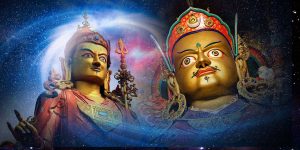Kurukulla Red Tara’s Power Mantra in Sanskrit chanted enchantingly 21 times
Very powerful chanting to original and memorable music dedicated to glorious Kurukulla, the immensely popular “Diva” Dakini of enlightened magic who transforms seduction into ‘the cause of wisdom.’ (Hard-subbed with mantra for chant-along.)
MANTRA
Oṃ kurukulle hūṃ hrīḥ svāhā
ओं कुरुकुल्ले हूं ह्रीः स्वाहा
NOTE: Her proper name is Kurukulla. Only the mantra uses the vocative form (Kurukulle) of her name.
LEARN MORE ABOUT KURUKULLA in our short “about Kurukulla” documentary here:
Guided Kurukulla meditation from Buddha Weekly: https://www.youtube.com/watch?v=ch-i7N7wa80
Kurukulla is like a beautiful, modern celebrity endorsing a worthy cause; she projects this divine and Enlightened beauty to attract us to the Dharma. She uses her enchanting “magic” to remove our obstacles to practice. We all need a little enchantment in our lives, don’t we?
For a full in-depth feature on Kurukulla, see BuddhaWeekly.com: https://buddhaweekly.com/kurukulla-the-diva-dakini-of-enlightened-magic-the-enchantress-transforms-seduction-into-the-cause-of-wisdom/
CHANTING: Generally, with Bodhichitta intention, anyone may chant this mantra, but without empowerment you only visualize Kurukulla in front of you, with yourself as your own Yidam.
Although it is always desirable to have lung for this mantra, because she is a form of Tara and also an emanation of Amitabha — none other than the slightly wrathful form of Padma Dakini — her mantra can be chanted by anyone with Bodhichitta intention — the intention to benefit all sentient beings. However, be guided by your own lineage teachings and your own teacher.
Her Tibetan name Rigiyedmna (རིག་བྱེད་མ) literally translates as “she who is the cause of knowledge”. Although she has her own tantras and practices, she is considered an emanation of Tara: Tarobhava Kurukulla, “the Kurukulla who arises from Tara” (Red Tara: sgrol-ma dmar-po.)
As a female deity, she is understood to embody the wisdom aspect of enlightenment (i.e., emptiness), and as a form of the savioress Tārā, herself a manifestation of Avalokiteśvara, she personifies all-embracing compassion.
More articles by this author

Chintachakra White Wish-Granting Wheel Tara: The All-in-One Mother of Buddhas in Vajrayana Buddhism – Her Significance, Mantra and Why Her Practice is Essential

VIDEO and PRACTICE: For Tara Days (and any day!) TARA’s GREAT DHARANI from Sutra chanted in Sanskrit

Tara’s Great Dharani Supreme of all Mantras –with Music version– and the Sutra of Tara Who Protects from the Eight Fears: in Tara’s Own Words

Tara Teaching from His Holiness the Sakya Trichen: Interview Q & A: Do you have a Tara Question? Chances are His Holiness Already Answered…
Search
Latest Features
Please support the "Spread the Dharma" mission as one of our heroic Dharma Supporting Members, or with a one-time donation.
Please Help Support the “Spread the Dharma” Mission!

Be a part of the noble mission as a supporting member or a patron, or a volunteer contributor of content.
The power of Dharma to help sentient beings, in part, lies in ensuring access to Buddha’s precious Dharma — the mission of Buddha Weekly. We can’t do it without you!
A non-profit association since 2007, Buddha Weekly published many feature articles, videos, and, podcasts. Please consider supporting the mission to preserve and “Spread the Dharma." Your support as either a patron or a supporting member helps defray the high costs of producing quality Dharma content. Thank you! Learn more here, or become one of our super karma heroes on Patreon.
Lee Kane
Author | Buddha Weekly
Lee Kane is the editor of Buddha Weekly, since 2007. His main focuses as a writer are mindfulness techniques, meditation, Dharma and Sutra commentaries, Buddhist practices, international perspectives and traditions, Vajrayana, Mahayana, Zen. He also covers various events.
Lee also contributes as a writer to various other online magazines and blogs.














